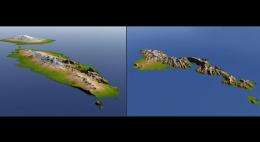Space Radar Reveals Topography of Tsunami Site

(PhysOrg.com) -- Two color-coded perspective views of the Independent State of Samoa (left) and American Samoa (right), generated with digital elevation data from the Shuttle Radar Topography Mission, illustrate the varying topography of the islands.
A tsunami generated by a major undersea earthquake on Sept. 29, 2009, inundated the more heavily populated southern coast of Tutuila, the largest of the islands of American Samoa, with an ocean surge more than 3 meters (10 feet) deep, causing scores of casualties.
The tsunami also inundated villages on the southern coast of the Independent State of Samoa with an ocean surge perhaps more than 3 meters (10 feet) deep, and also impacted the more heavily populated northern coasts with a surge measured at nearly 1.5 meters (4 feet) at the capital city of Apia.
Digital topographic data such as those produced by SRTM can be used to aid researchers and planners in predicting which coastal regions are at the most risk from such waves, as well as from the more common storm surges caused by tropical storms and even sea level rise.
Provided by JPL/NASA (news : web)

















